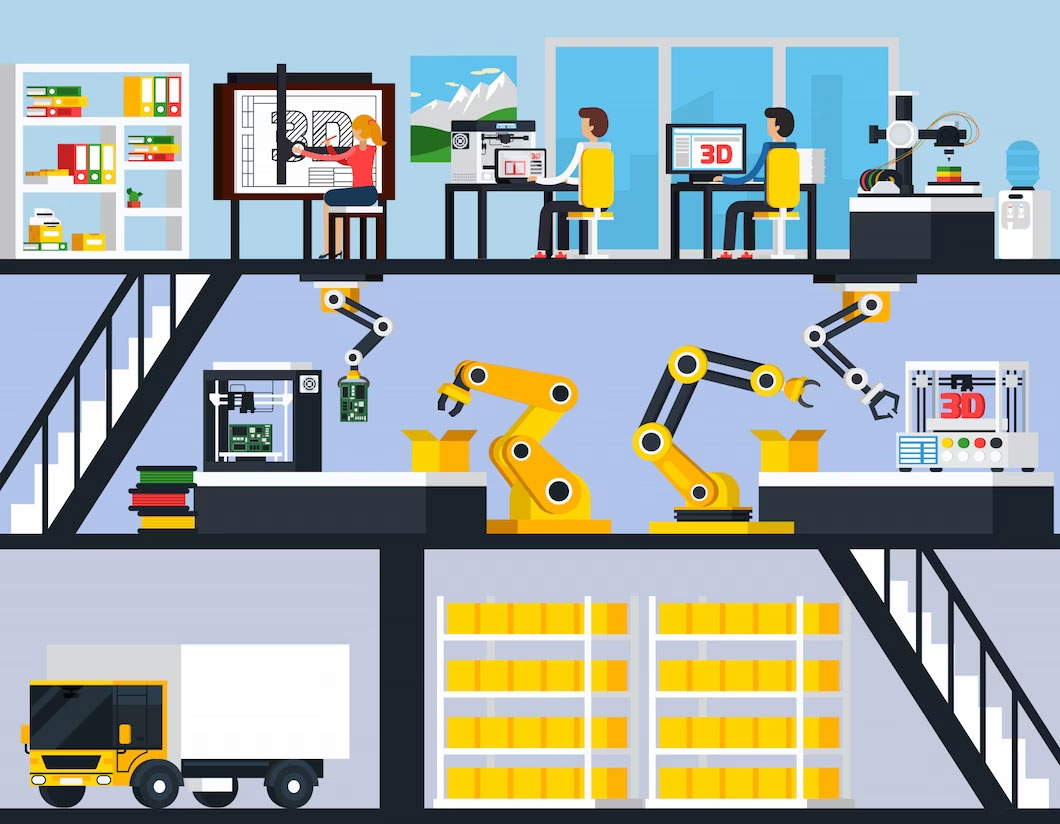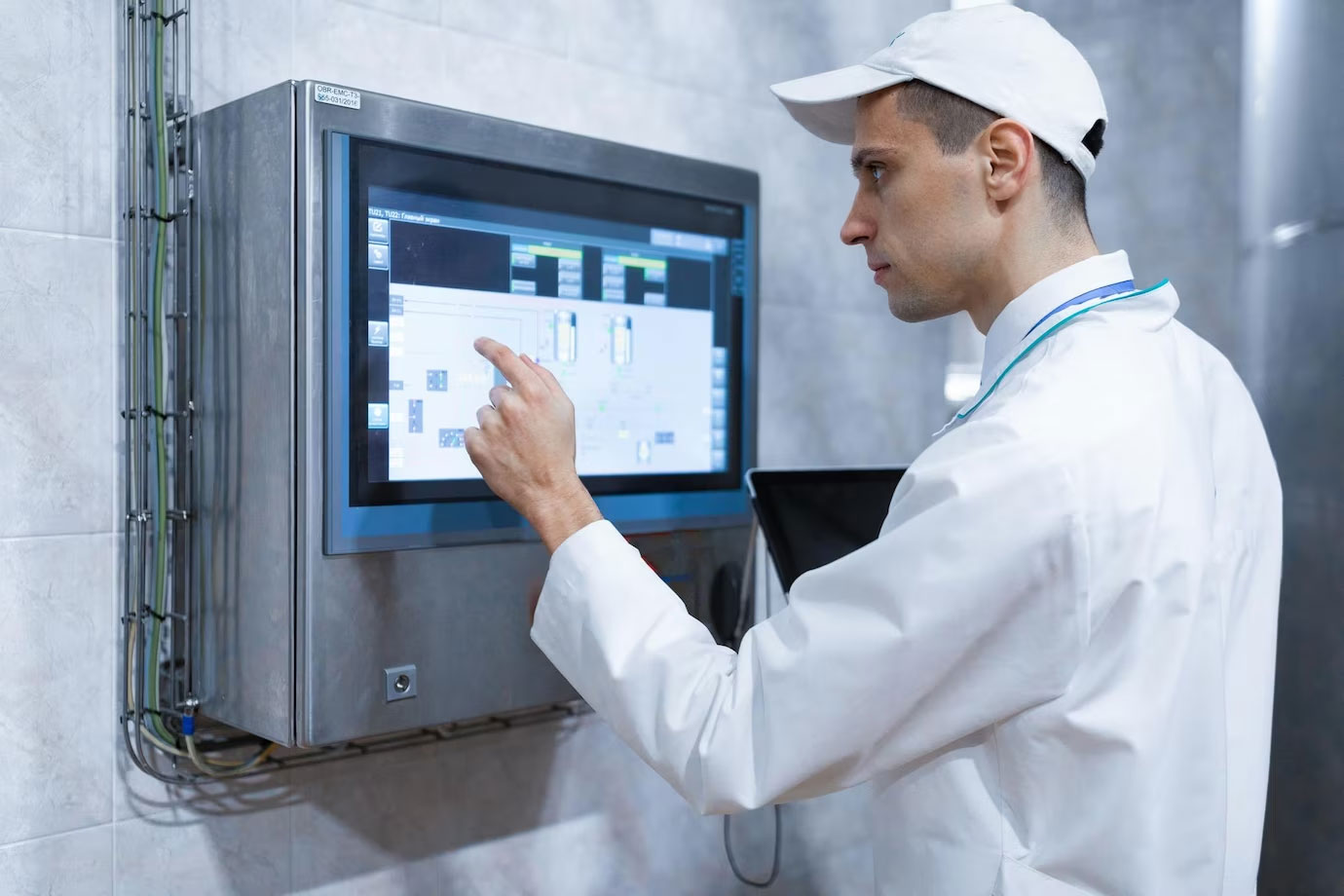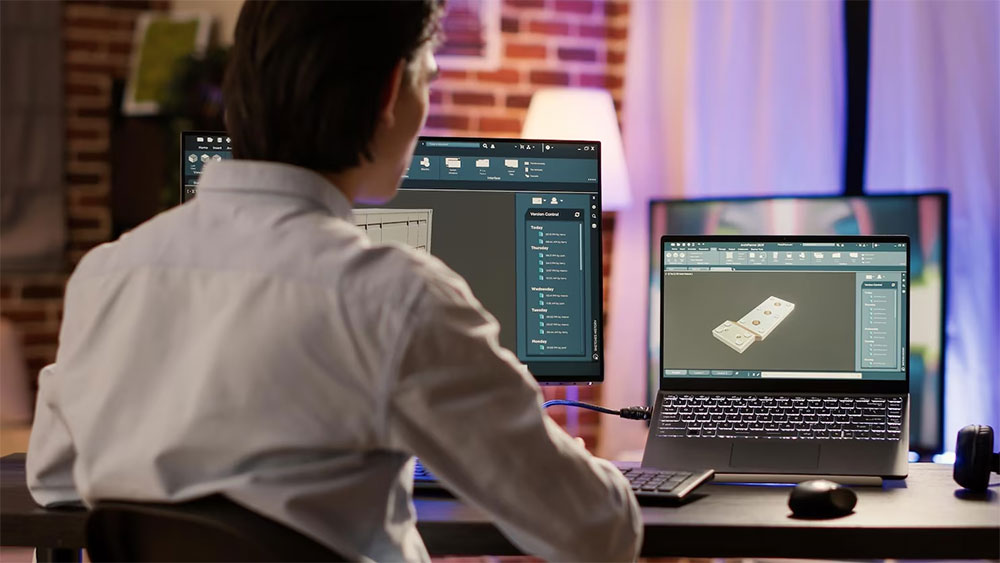This preface sets the stage for an exploration into the world of industrial touch screen PCs, delving into their applications, benefits, and the profound impact they have on diverse sectors. From manufacturing floors to control rooms, these rugged and advanced computing solutions are reshaping the way businesses operate, enhancing productivity, data-driven decision-making, and reimagining the boundaries of human-machine collaboration.
Manufacturing Control and Monitoring
Industrial touch screen PCs are commonly used in manufacturing environments to monitor and control production processes, track machine performance, and ensure quality control.
The Significance of Manufacturing Control and Monitoring
Industrial Monitor manufacturing control involves the management and regulation of various aspects of the production process to ensure that everything runs smoothly and according to predetermined standards. Monitoring, on the other hand, involves tracking and analyzing data in real-time to identify anomalies, trends, and potential issues that could affect production quality or efficiency. When combined, these two components create a powerful system that can lead to numerous advantages for manufacturers.
Benefits of Manufacturing Control and Monitoring
Enhanced Quality: One of the primary benefits of implementing robust control and monitoring systems is improved product quality. By closely monitoring various process parameters, manufacturers can quickly identify deviations and take corrective actions before defective products are produced. This results in fewer defects, reduced scrap rates, and higher customer satisfaction.
Increased Efficiency: Real-time monitoring allows manufacturers to optimize their processes for maximum efficiency. By analyzing data on factors such as machine performance, energy consumption, and production rates, companies can make informed decisions to minimize downtime, reduce cycle times, and optimize resource allocation.
Cost Savings: Efficient processes and reduced defects naturally lead to cost savings. With better control and monitoring, manufacturers can minimize waste, reduce rework, and lower energy consumption, all of which contribute to improved profitability.
Predictive Maintenance: Monitoring equipment health in real-time enables predictive maintenance. By analyzing data patterns, manufacturers can anticipate when equipment is likely to fail and perform maintenance before a breakdown occurs. This approach minimizes unplanned downtime and extends the lifespan of machinery.
Data-Driven Decision-Making: Manufacturing control and monitoring generate a wealth of data that can be used for informed decision-making. By analyzing historical and real-time data, manufacturers can identify trends, optimize processes, and make strategic choices to enhance their operations.
Human-Machine Interface (HMI)
These PCs serve as interfaces between operators and complex machinery, allowing them to interact with and control equipment in real-time.
The Human-Machine Interface (HMI) is a crucial application of industrial touch screen PCs. It serves as the bridge between humans and machines, allowing operators to interact with and control complex machinery in various industries.
With an intuitive touch screen interface, HMI systems provide real-time data visualization, enabling operators to monitor machine performance, analyze production metrics, and make informed decisions. This seamless interaction enhances productivity and efficiency on the factory floor.
In manufacturing plants, HMIs enable operators to easily adjust machine settings or troubleshoot issues without interrupting production. They can access detailed information about equipment status, set up automated processes, and receive alerts for any abnormalities or maintenance requirements.
In addition to manufacturing control and monitoring, HMIs find applications in other sectors such as energy management. With these systems in place, operators can monitor power usage patterns and optimize energy consumption to reduce costs while maintaining operational efficiency.
Furthermore, HMIs are essential in healthcare settings where precision is paramount. Medical professionals rely on touch screen interfaces for patient monitoring systems, diagnostic equipment control panels,and operating room displays. The user-friendly nature of these interfaces enables healthcare providers to focus on patient care rather than navigating complicated menus.
Overall,HMIs revolutionize the way we interact with machines across various industries.
They enhance productivity,enabling faster decision-making,data analysis,and troubleshooting.

This technology continues to evolve,giving us more efficient ways of controlling,maintaining,and optimizing our industrial processes.
With their user-friendly interfaces,HMIs empower workers by providing them with valuable insights into machine operations,resulting in improved overall performance.
Process Automation
Touch screen PCs facilitate the automation of various industrial processes, reducing manual intervention and increasing operational efficiency.
Process automation is one of the key applications of industrial touch screen PCs. With their advanced technology and user-friendly interface, these devices can streamline and optimize various processes in industries such as manufacturing, logistics, and utilities.
By integrating touch screen PCs into the production line, companies can automate repetitive tasks, reducing human error and increasing efficiency. These devices can control machinery and equipment with precision, ensuring consistent output and minimizing downtime.
In addition to controlling individual machines, industrial touch screen PCs can also coordinate multiple processes to create a seamless workflow. They can communicate with other systems such as sensors, actuators, and PLCs (programmable logic controllers) to monitor parameters like temperature, pressure, or speed. This real-time data enables automated adjustments to be made for optimal performance.
Furthermore, process automation through touch screen PCs allows for remote monitoring and control. Managers can access the system from anywhere using secure internet connections or dedicated software applications. This not only provides greater flexibility but also enhances safety by reducing the need for on-site personnel.
Process automation with industrial touch screen PCs revolutionizes industries by improving productivity while maintaining high quality standards. It is an essential tool for modern businesses striving for operational excellence in today’s competitive market.
Inventory Management
In warehouses and distribution centers, these Industrial Box PC help manage inventory levels, track shipments, and optimize logistics operations.
Inventory management is a crucial aspect of any business, and industrial touch screen PCs have revolutionized the way it is done. With their advanced features and user-friendly interfaces, these devices make inventory tracking and monitoring a breeze.
One application of industrial touch screen PCs in inventory management is real-time stock tracking. These devices allow you to keep track of your inventory levels in real-time, ensuring that you always know what products are available and when to reorder. This helps prevent stockouts and ensures that customers never face disappointment due to unavailability.
Another benefit is improved accuracy in inventory counts. Industrial touch screen PCs enable barcode scanning capabilities, making it easy to scan items as they are received or sold. This eliminates the need for manual counting, reducing human error and improving overall accuracy.

Furthermore, these devices can be integrated with other systems such as customer relationship management (CRM) software or enterprise resource planning (ERP) systems. This integration allows for seamless data sharing between different departments within an organization, streamlining processes and ensuring efficient operations.
In addition to tracking stock levels, industrial touch screen PCs also provide analytics tools that help analyze sales trends and forecast future demand. By analyzing this data, businesses can optimize their inventory management strategies by identifying slow-moving items or predicting spikes in demand during peak seasons.
Industrial touch screen PCs have transformed the way businesses manage their inventories. From real-time stock tracking to improved accuracy in counts and advanced analytics capabilities, these devices offer numerous benefits for effective inventory management.
Data Visualization and Analysis
Touch screen PCs are used to display and analyze data from sensors, helping operators make informed decisions based on real-time insights.
The Advantages of Data Visualization and Analysis
- Enhanced Clarity: Humans are inherently visual learners, and data visualizations provide a more intuitive way to understand complex information. By representing data graphically, patterns and trends become more apparent, aiding in quicker comprehension and interpretation.
- Effective Communication: Visualizations simplify the communication of complex ideas and findings. When presenting data to a non-technical audience, visuals help convey information clearly and facilitate discussions between different stakeholders.
- Identifying Trends and Anomalies: Visualizations make it easier to spot trends, anomalies, and outliers within data sets. This can lead to quicker detection of issues or opportunities that might have gone unnoticed in a table of numbers.
- Data-Driven Decision-Making: Informed decision-making requires a solid understanding of the data at hand. Data visualizations enable decision-makers to gain insights quickly and make well-founded choices based on the patterns they observe.
- Storytelling with Data: Visualizations can be used to tell a story with data, guiding the audience through a narrative that highlights key findings and insights. This storytelling approach makes data more engaging and memorable.
Tools and Techniques for Effective Data Visualization and Analysis
- Graphs and Charts: Bar graphs, line charts, pie charts, and scatter plots are commonly used to represent various types of data relationships. Each type of chart is suited to different types of data and insights.
- Interactive Visualizations: Interactive elements in visualizations allow users to explore data on their own terms. These visualizations often provide filters, tooltips, and zooming capabilities for deeper exploration.
- Dashboards: Dashboards consolidate multiple visualizations onto a single screen, providing a comprehensive overview of data trends. They are particularly useful for monitoring real-time data and KPIs (Key Performance Indicators).
- Heatmaps: Heatmaps visually represent data density and intensity using colors. They are especially useful for identifying patterns in large datasets.
- Geospatial Visualization: Maps and geographic visualizations are used to display data in relation to geographical locations, offering insights that can be valuable for businesses with location-based considerations.
Energy Management
They play a role in monitoring energy consumption and optimizing energy usage in industrial facilities to reduce costs and environmental impact.
In today’s world, energy conservation has become a top priority. With the rising costs of electricity and increasing environmental concerns, businesses are actively seeking ways to optimize their energy usage. This is where industrial touch screen PCs come into play.
Industrial touch screen PCs offer advanced features that enable efficient energy management. They can be integrated with smart meters and sensors to monitor real-time power consumption across different areas of a facility. By analyzing this data, businesses can identify patterns and trends in energy usage, allowing them to make informed decisions about optimizing their operations.
Furthermore, industrial touch screen PCs provide easy access to detailed reports and analytics related to energy consumption. This allows businesses to track their progress in reducing energy usage over time and implement strategies for further improvement.
Additionally, these ruggedized computers can be used for scheduling and controlling various equipment within a facility. By automating processes such as lighting systems or HVAC units based on occupancy levels or specific time intervals, businesses can significantly reduce unnecessary energy wastage.
Moreover, industrial touch screen PCs facilitate remote monitoring and control of critical infrastructure components like generators or solar panels. Operators can easily adjust settings or perform maintenance tasks from a centralized location without physically accessing each device individually.
By harnessing the power of industrial touch screen PCs for energy management purposes, businesses can not only reduce costs but also contribute towards sustainable practices that benefit both the environment and their bottom line.
Quality Assurance
Industrial touch screen PCs are used to inspect and ensure the quality of products during different stages of the manufacturing process.
Key Aspects of Quality Assurance for Industrial Touch Screen PCs
Robust Design and Materials: The quality assurance process begins with the design phase. Components and materials must be carefully selected to ensure they can withstand the environmental challenges posed by industrial settings. QA engineers work closely with designers to validate the durability of the device’s housing, touch screen, and internal components.
Environmental Testing: Industrial touch screen PCs are subjected to a battery of environmental tests, including temperature and humidity variations, mechanical stress tests, and vibration simulations. These tests ensure that the devices can perform consistently in demanding conditions without compromise.

Touch Screen Calibration: The accuracy and responsiveness of touch screens are crucial for user interaction. QA involves meticulous calibration testing to ensure that touch screens respond accurately and reliably to user input across different environments.
Software Performance: Industrial touch screen PCs often run critical software applications for controlling machines and processes. QA includes thorough testing of software compatibility, stability, and performance to prevent glitches, crashes, or delays that could disrupt operations.
Electromagnetic Interference (EMI) Testing: Industrial environments can be rife with electromagnetic interference from various sources. QA includes testing to ensure that touch screen PCs can function properly without being affected by or causing EMI.
Usability Testing: QA also addresses the user experience. Usability testing ensures that the user interface is intuitive and user-friendly, enabling operators to navigate and interact with the device efficiently.
Benefits of Quality Assurance in Industrial Touch Screen PCs
Reliability: Rigorous QA ensures that industrial touch screen PCs can consistently perform under extreme conditions, minimizing downtime and disruptions to operations.
Longevity: Devices that pass quality assurance tests are more likely to have a longer lifespan, reducing the need for frequent replacements and associated costs.
Operational Efficiency: Quality-assured devices enable smooth and accurate interactions, leading to enhanced productivity and reduced chances of errors.
Safety: In industrial environments, malfunctions or errors in touch screen PCs could lead to safety hazards. QA helps prevent these risks, ensuring a safer workplace.
Customer Trust: Investing in QA demonstrates a commitment to delivering reliable and high-quality solutions, building trust with customers and enhancing the brand’s reputation.
Control Room Operations
In control rooms of various industries (e.g., oil and gas, utilities), touch screen PCs provide operators with a comprehensive overview of operations, alarms, and safety systems.
Control Room Operations play a vital role in industries that require constant monitoring and control of various processes. Industrial touch screen PCs are used extensively in control rooms to provide operators with real-time data and controls.
With the help of industrial touch screen PCs, operators can easily access and monitor multiple systems simultaneously, such as temperature sensors, pressure gauges, flow meters, and more. These touch screen interfaces allow operators to quickly identify any abnormal conditions or potential issues.
In addition to monitoring, industrial touch screen PCs also enable operators to make adjustments and perform necessary actions remotely. This reduces the need for physical presence near the equipment or machinery being controlled, improving safety and efficiency.

Moreover, these ruggedized PCs are designed to withstand harsh environmental conditions typically found in control room settings. They have built-in protection against dust, water ingress, electrical interference, shocks, vibrations – ensuring uninterrupted operation even in challenging environments.
The intuitive user interface provided by industrial touch screen PCs simplifies complex operations. Operators can easily navigate through different screens using multi-touch gestures or stylus pens. This ease of use enhances productivity while minimizing human errors during critical decision-making processes.
Conclusion
Industrial touch screen PCs are a powerful and versatile tool for businesses in the food and beverage industry. They provide an efficient interface for managing complex manufacturing processes, enable real-time data collection and analysis, and facilitate compliance with regulatory standards. Furthermore, their robust construction makes them ideal for use in environments where stringent hygiene protocols must be maintained. All of these features make industrial touch screen PCs an invaluable addition to any food or beverage production operation.